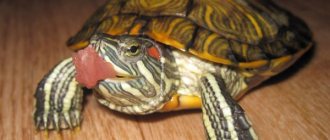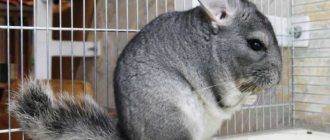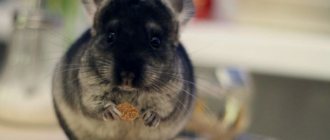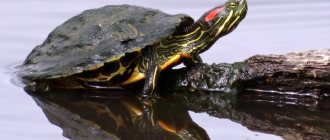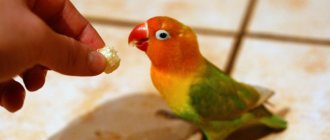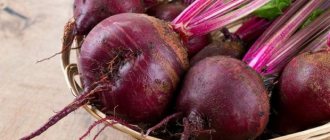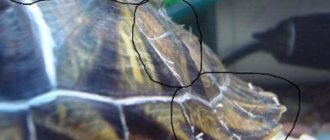Aquatic ornamental turtles are frequent inhabitants of home aquariums. These cute reptiles are loved by children and adults alike. In order for a turtle to live a long and fulfilling life in a closed tank, you need to create appropriate living conditions for it and pay special attention to the correct diet.
In the article we will look at popular brands of complete food and treats for aquatic turtles, how many times a day, at what time and how to feed them correctly, whether turtles need mineral and vitamin supplements, differences in the diet of adult and small pets, and also depending on the species turtles.
Food of animal origin
It is recommended to feed the red-eared turtle at home with animal food. Its content in the diet should be 70%. These reptiles love meat products very much, but preference should be given to beef, horse meat, and poultry. You can also give them fish, seafood, and they don’t mind eating insects.
Meat
When kept in an aquarium, the reptile can be fed meat. But it is better to use low-fat varieties - beef, rabbit, they will be happy to eat small pieces of chicken. But you should not give such types of meat as pork and lamb, the fact is that these varieties have high fat content. Consumption of these varieties may cause disruption of the digestive system.
What kind of meat food should you feed your turtle:
- the diet should contain by-products - heart, liver, navels;
- meat with lean variety. It can be given raw or boiled. It should be given to turtles in small pieces;
- turtles can be fed with small mice.
Note! If you constantly give your pet raw meat, this can quickly lead to the development of hypovitaminosis A, as well as the appearance of rickets. For this reason, you need to include several different foods in your diet.
Fish and seafood
Fish can be used as food, but it must be a low-fat variety. But your veterinarian can tell you what kind of fish you can feed your reptile.
Be sure to properly prepare it before feeding:
- First of all, the carcass is cleaned of scales;
- Next, take out all the entrails and bones;
- The cleaned fillet is cut into small pieces and after that they can be lowered into the aquarium or placed in a feeder;
- It is worth considering that the fish contains the enzyme thiaminase, so before giving it to the turtle, it is better to immerse the cleaned fillet in boiling water for a few minutes.
In its raw form, it is allowed to give a cocktail of marine components. This royal treat usually includes ingredients such as green shrimp, octopus and squid. Feed reptiles with snail meat; this component is considered an excellent addition to the main diet.
You should not put a turtle in an aquarium together with aquarium fish. Fish such as guppies, swordtails, goldfish, carp, and catfish are excellent food for amphibians.
Insects
What can you feed red-eared turtles at home in the summer? These reptiles are very fond of various insects, which begin their active activity in the warm season.
The following types of insects can be included in the amphibian menu:
- reptiles happily eat grasshoppers;
- in order for the reptile to be happy, you can give it non-shaggy caterpillars, bloodworms;
- you can include a mealworm in the menu, which is sold in many pet stores;
- It is imperative to supplement the diet with dried or live gammarus;
- sometimes you can give coretra and daphnia. But during the feeding period, it is recommended to turn off the filter for about 15 minutes.
Reproduction at home
When turtles live in their natural environment, they begin to reproduce only after reaching 6-8 years of age. When turtles are kept in an artificial environment, they are ready to reproduce at a maximum of 5 years of age. Under natural conditions, the reproduction process begins at the end of February and lasts until May. Having met a female, the male tries to position himself as close to the female’s head as possible.
When the time comes to lay eggs, the female leaves the pond and heads to land, where she begins to search for a suitable place. After this, she wets the soil with water, which she prudently stored in the anal bladders. Then the female begins to form a nest.
To do this, she uses her hind legs. As a result of the active actions of the turtle, a ball-shaped nest is formed, the diameter of which, depending on the type of turtle, can reach up to 7-25 cm.
The female lays from five to twenty eggs at a time, the diameter of which is up to 4 cm on average. After this process, the turtle covers them with soil. Turtles do not care about their future offspring and immediately climb back into the sea (into the water). Eggs develop at temperatures from +21 to +30 degrees for 3-5 months. When the development of eggs occurs at a temperature of +27 degrees and below, then males are born, and when at a temperature of about +30 degrees and above, females are born.
A crowd of red-eared turtles!
Watch this video on YouTube
Plant food
In order to properly maintain reptiles, it is worth including in the menu not only animal food, but also plant food mixtures. Plants can be fed to young and adult individuals, and with age the amount of this food should increase.
When keeping a turtle in an aquarium, the menu must include the following herbal components:
- Various types of grass. Amphibians should be fed plantain, clover, leaves and flowers from dandelions, and rhubarb. Turtles are especially fond of coltsfoot leaves, sprouted grains of oats and barley;
- Reptiles will happily eat plums, banana pulp, pear slices, juicy pitted peaches, mangoes; it is advisable to cut all these fruits into small pieces. You can also give orange, tangerine, pieces of melon pulp;
- Freshwater animals can eat aquarium vegetation. In the aquarium you can plant duckweed, spirogyra, water beetle, and pond algae;
- Vegetables must be included in the menu. The most favorite vegetables include bell peppers, cucumbers, tomatoes, eggplants, zucchini, pumpkin, radishes, celery, legumes, carrot roots, and beets. But white cabbage and other varieties of this vegetable should not be given;
- Once every 7 days, the turtle can be given pieces of mushrooms such as boletus, champignons, and russula.
Important! Is it possible to give reptiles food from the human table (bread, cheese, cottage cheese, sausage, cereals and others)? In no case, it can negatively affect the functioning of the digestive system. Also avoid feeding pet food, citrus peels, and berries with seeds.
Caring for your turtle
The first thing you should pay attention to when purchasing a pet is its appearance and size. A turtle that is under 5 cm in size at the time of purchase will be very difficult to raise. At this age, small individuals are susceptible to various infections and diseases.
This is how natural selection takes place. Therefore, a turtle 5–7 cm in size will be the best choice when purchasing
At this age, small individuals are susceptible to various infections and diseases. This is how natural selection takes place. Therefore, a turtle 5–7 cm in size will be the best choice when purchasing.
You should also carefully examine the color of the shell. The claws and tail must be intact. The skin looks healthy and the eyes shine. After the pet is in the aquarium, watch how it swims. A healthy turtle should swim smoothly, without leaning in different directions.
Healthy turtle
Features of treatment
After purchasing a pet and moving it into an aquarium, it may go through an adaptation period. Typically it will take 2 to 5 days. At this time, the animal becomes a little inhibited, or, conversely, very active. There is no need to panic and pick up the animal. Give him peace and time to adapt to new conditions. After a while, the turtle will get used to the new environment and become calmer.
When trying to pick up a turtle, do it very carefully and always with both hands. Not all representatives are willing to make contact. Some may flounder, hiss, and defecate in fear. The shell becomes slippery in water; keep this fact in mind when removing your pet from the aquarium.
After you hold the turtle in your hands, be sure to wash them with soap. Despite being kept clean, turtles are often carriers of salmonellosis. To avoid the spread of infection, you must always monitor the condition of the aquarium and the quality of the food.
Cleaning the shell
Since green algae in an aquarium is a source of infection, it is important to regularly clean not only the container, but also the turtle’s shell. They cannot do this themselves. During the decomposition process, algae also fall under the surface of the shell, and as they decompose, they harm the shell
During the decomposition process, algae also fall under the surface of the shell, and as they decompose, they harm the shell.
You will get used to the fact that once every 3-5 days you need to take the turtle out of the water and wipe its shell with a clean cloth, a special soft napkin, or gently brush it with a toothbrush. During the process, you should try to remove all small particles of algae and other dirt.
Cleaning the shell with a toothbrush
Some unscrupulous owners try to make the turtle's shell beautiful and lubricate it with various oils or creams to add shine. This is strictly prohibited, as it harms the skin and interferes with the healthy “breathing of the body” of the pet.
What to feed baby turtles
What can you feed a small red-eared turtle in captivity? After all, it is important that baby reptiles have full development and good health right from the first days. And their well-being directly depends on a balanced diet.
When creating a menu for small turtles, you should consider the following important recommendations:
- the diet should consist of balanced and varied components;
- It is better to give the cubs more food of animal origin;
- Sea or river fish is considered healthy, it should be almost 80% of the menu;
- the remaining 20% should be crustaceans, offal, mollusks, insects;
- You can add guppies, mollies, and swordtails to your kids’ aquarium.
What can overfeeding cause?
Owners of red-eared reptiles often come to veterinarians complaining about the apathy of their aquatic pets. At the same time, the animal’s diet consists of natural products, and the diet is very varied. The problem is that animals eat too often or too heavily. Large portions of food often lead to disastrous consequences, one of which is digestive disorders.
When getting a red-eared creature, you need to think about the animal’s diet in advance. Despite the fact that turtles require a variety of food, their portions are negligibly small and pets eat very rarely. Even the laziest animal lover can have an adult turtle, which he will have to feed once a week. However, do not forget that the animal should not be overfed, nor should it be abused with dry food.
Sources:
https://myturtle.ru/chem-kormit-krasnouxuyu-cherepaxu/ https://womanadvice.ru/chem-kormit-krasnouhuyu-cherepahu-chto-mozhno-davat-chto-nelzya https://rybkies.ru/obitateli /kormlenie-krasnouhoj-cherepahi.html
Is it necessary to include mineral and vitamin supplements?
Additional fortified supplements are required for young individuals in whom the formation of the bone skeleton, strengthening and construction of the shell occurs. It is during this period that they require increased levels of calcium.
So what supplements should be included in the reptile menu:
- Every day you should add ground bone meal to your food. A pinch is enough for small turtles, but for adults it is recommended to add 1 teaspoon to the aquarium every 7 days;
- You can mix special vitamins into the food. Dosages are usually indicated in the instructions;
- You can include fortified feed mixtures in the menu.
How to feed turtles
How to properly feed red-eared turtles? How many times a day should I feed my red-eared slider? These questions interest many breeders of these reptiles, but there is no exact answer to them. Everything may depend on the age of the reptile, its body size, and the types of food mixtures that pets eat.
But you can take note of a few useful tips:
- individuals under 1 year of age can be given plant components, and low-fat varieties of fish and meat can also be included. They need to be fed every day;
- individuals from 1 year and older can be fed less, usually switching to a diet of 1 time every two days. The amount of food will depend on the size of the reptile.
Knowing what a turtle of this species eats, as well as feeding rules, will ensure a long period of life for this reptile in an apartment or house. The pet will be able to please its owner with a healthy and beautiful appearance, as well as an active lifestyle. The main requirement is proper and careful care of the amphibian animal.
Diet of the red-eared slider
The diet of red-eared turtles is compiled taking into account the fact that this type of reptile belongs to predators, therefore the main element in their menu is animal food, and plant food is used as a supplement in the amount of 25-30% of the total food. When developing a diet, the age of the pet is also taken into account; for the diet of reptiles under one year old, use those products that contain more protein. The nutritious diet is divided into winter and summer, while fresh vegetables can be replaced with frozen foods or dry food.
